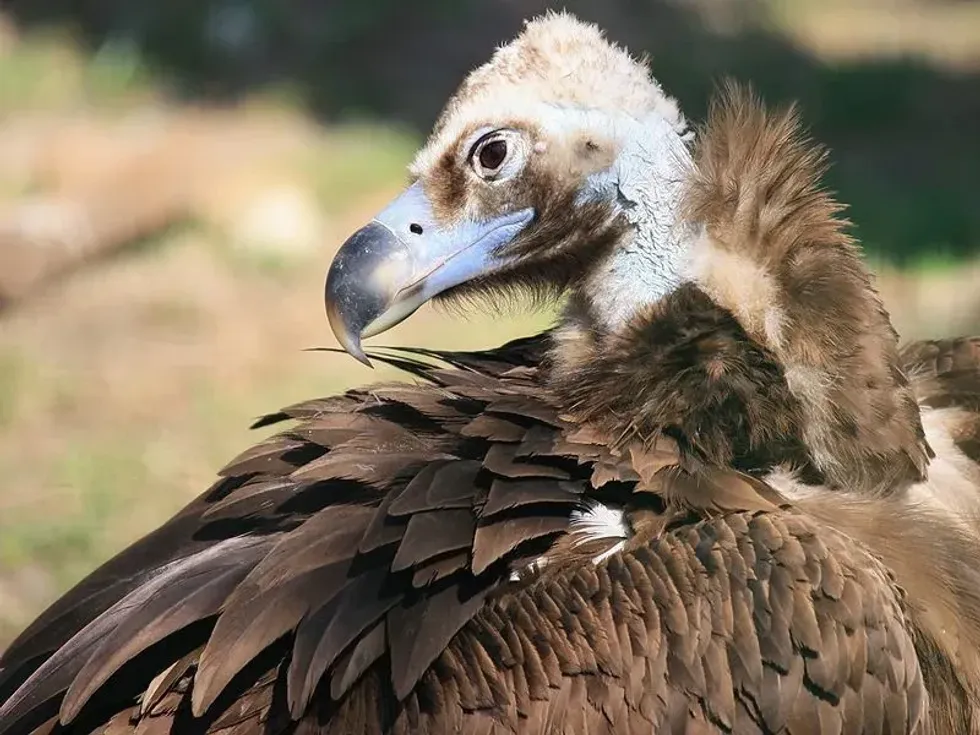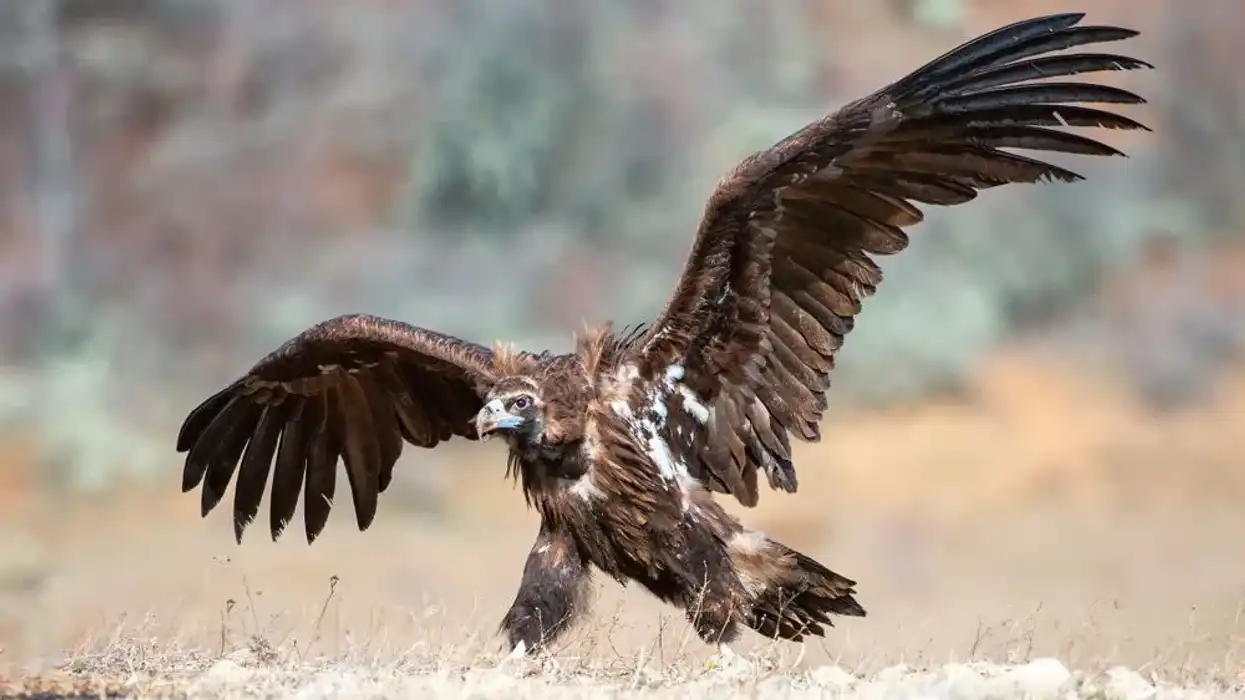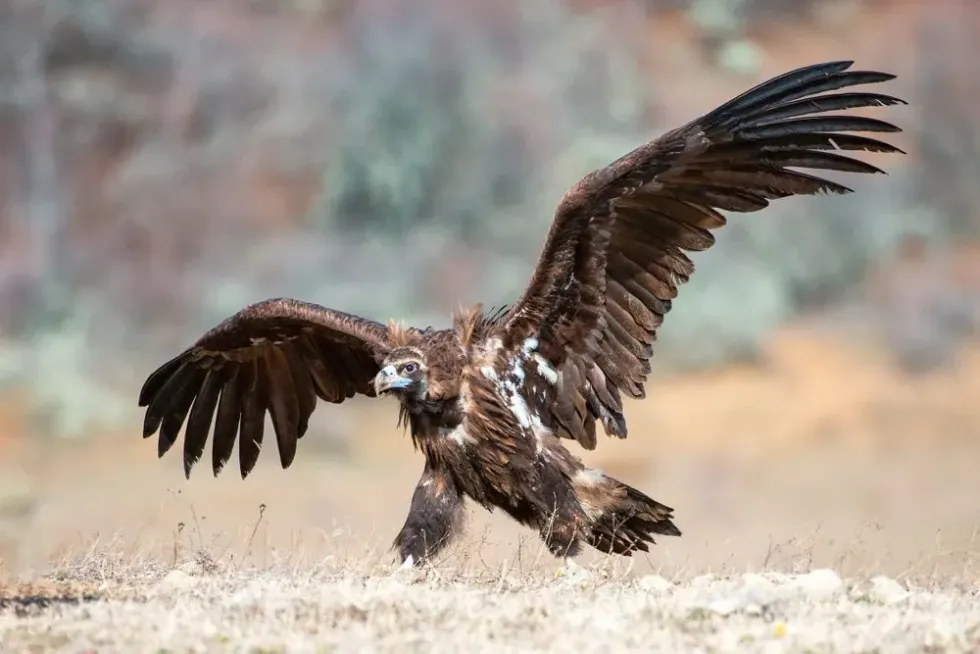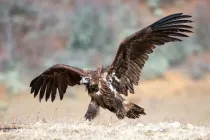Fun Cinereous Vulture Facts For Kids
Content
- What type of animal is a cinereous vulture?
- What class of animal does a cinereous vulture belong to?
- How many cinereous vulture are there in the world?
- Where does a cinereous vulture live?
- What is a cinereous vulture habitat?
- Who do cinereous vulture live with?
- How long does a cinereous vulture live?
- How do they reproduce?
- What is their conservation status?
- What do cinereous vulture look like?
- How cute are they?
- How do they communicate?
- How big is a cinereous vulture?
- How fast can a cinereous vulture fly?
- How much does a cinereous vulture weigh?
- What are the male and female names of the species?
- What would you call a baby cinereous vulture?
- What do they eat?
- Would they make a good pet?
- Did you know...
- Why is the cinereous vulture endangered?
- What is the largest vulture in the world?
Cinereous vultures, who have the scientific name Aegypius monachus, are considered to be the largest species of vulture. In many places, this magnificent bird of prey is more commonly known as an Eurasian black vulture.
They also have some other names, such as monk vulture or black vulture. They fly at great heights and, due to their enormous wingspan, they resemble small patrolling airplanes while in flight.
This Old World vulture has many similarities with vultures of the new world, but they form an entirely separate family from new world vultures, called Accipitridae.
The population of all species of vultures has decreased a lot in recent years. Many countries have created species survival plans for cinereous vultures that tried to protect the species, which has proven to be successful.
For example, in 1970, their population had decreased to only 200 pairs, but these measures increased their number to 1000 pairs in 1992. Before facing the threat Extinction, they were seen widely and covered a great range in Europe and Asia.
To know more details about this glorious bird, continue reading the cinereous vulture facts. If you enjoyed this fact file, you should read our articles on these griffon vulture facts and king vulture facts.
Cinereous Vulture Interesting Facts
What type of animal is a cinereous vulture?
Cinereous vultures (Aegypius monachus) are a member of the bird family. More specifically, they are one of the 15 old world species of vulture that come from Europe, Asia, and Africa.
What class of animal does a cinereous vulture belong to?
These large and magnificent raptor birds of the order Accipitriformes belong to the class Aves.
How many cinereous vulture are there in the world?
The population of cinereous vultures is currently Threatened. These birds are becoming rarer day by day.
The western half of their distribution has faced the worst consequences, and they have become Extinct in many European countries such as Italy, Slovakia, France, Austria, Poland, and Romania. The estimated population of cinereous vultures is between 7,800-10,500 pairs. In Europe, around 2,300 and 2,500 pairs are present, and Spain accounts for 95% of the European population.
Asia acts as a home to between 5,500 and 8,000 pairs. In almost all countries where they existed, these raptors are either Extinct, Endangered, or Near Threatened.
Where does a cinereous vulture live?
The large and majestic Old World cinereous vultures cover a large range of the Eurasian countries ranging from eastern to southern Europe, central Asia, and some discrete parts of the Middle East, Turkey, and Greece.
In the west, the cinereous vulture populations extend to Spain and Portugal, and the eastern limit extends to Manchuria, Mongolia, and Korea.
Apart from that, cinereous vulture distribution covers countries like Georgia, Bulgaria, Russia, Ukraine, northern India, Iran, Afghanistan, and many more. A population has been reintroduced in France by releasing some captive-bred vultures in the wild.
Cinereous vultures mostly settle in their own nesting sites permanently except the northernmost populations, especially at the young vultures, that travel southwards to the countries like Bhutan, Myanmar, North and South Korea, Sudan, and rarely in the Middle East during harsh winters.
What is a cinereous vulture habitat?
The cinereous vulture habitats are found in temperate European countries, Asia, and northern Africa. They prefer to restrict their habitat to the mountains or in the hilly regions inhabiting the semi-open terrains, dry and arid rocky areas, as well as in thick forests.
They nest in the remote and undistributed trees of high mountains where human habitation is comparatively less and.
Asian vultures are well adapted to exist in the rocky scrublands and arid or semi-arid steppes of alpine vegetation. However, European populations rarely nest in this type of habitat and are generally absent in the drylands.
The Asian cinereous vultures nest at higher altitude meadows of up 14,764 ft (4500 m) than the European vultures that can be seen at elevations starting from 328 ft (100 m) only.
Vultures generally do not migrate, but the young vultures of the northern stretch might cover long distances over dry habitats when they face extreme temperatures during summer or winter. Cinereous vultures nest in dark and covered places.
Who do cinereous vulture live with?
Most raptor bird species tend to live in solitary, but vultures are an exception. This species is often found to flock in groups, feeding on different types of carrion and food together and flying or roosting their nests together.
A group of vultures is called a committee. Their group is known as wake while feeding and a kettle when they fly and search for food together. Within a group, they are more closely related to their respective pair and their family members than other individuals.
How long does a cinereous vulture live?
Cinereous vultures can have a long life. As bird species, their lifespan is much longer than many other birds. In the wild, a cinereous vulture can stay alive for a range of 20-28 years old. In the wild, the average age for vultures is 20 years.
In captivity, these vultures can even live up to 35 years. The highest recorded age of a cinereous vulture was observed to be 40 years. The lifespan of these animals depends entirely on them and their feeding habits.
How do they reproduce?
Cinereous vulture's breeding season lasts from February to September. These birds start to return to their breeding sites in January or February.
They breed in loose colonies and form their nests in different trees apart from other pairs. The most common display flight of adult pairs is flying in a synchronous pattern and descending spirally from the sky together by locking their talons.
These vultures build enormous nests at first where they lay an egg. These nests are made up mainly of twigs and branches and are built strong enough to accommodate vultures.
Both parents play equally important roles in nourishing and feeding the young. Cinereous vultures are monogamous animals and mate with a single partner for the rest of its life.
They mate once a year and only produce a single egg per breeding season.
On very rare occasions, two eggs are produced. After an incubation period of 50-60 days, the egg or in some cases, the dual eggs hatch in the summer season.
The first feathers start to grow on the juvenile birds after 30 days of their birth and become fully covered by 60 days. When the baby vulture turns 104-120 days old, fledging is noticed under the guidance of their parents.
Cinereous vultures reach sexual maturity at the age of 2-3 years. They put enormous efforts into protecting their eggs and nurturing young ones and during the breeding season, vultures protect their nests from nearby old roosting trees.
What is their conservation status?
According to the IUCN Red List data, cinereous vultures are enlisted as a Near Threatened species in the list. The main threat that these vultures are facing is habitat destruction.
Apart from that, overhunting, consuming poisoned carrion, less availability of carrion, the disappearance of breeding habitats, and disturbance in their nests. Spain ranks number one in the cinereous vulture population, followed by Turkey.
Shooting vultures have been declared illegal in many places. Despite that, these practices have constantly been taking place and sometimes they are also captured illegally and put in zoos around the world.
Cinereous Vulture Fun Facts
What do cinereous vulture look like?
The physical appearance of the Old World Eurasian black vulture known as the cinereous vulture (Aegypius monachus) is totally different from the physical appearance of the New World species of the American black vultures.
One of the largest flying birds, the cinereous vultures have a dark body covered with dark brown or black feathers all over except the pale top portion of the head in adults.
The head and neck portion have a distinct bluish-gray skin cover which turns pale and dirty white above the eye. Around the neck ruff, black feathers known as down are present.
Their bills and legs are also bluish-gray in color. From a distance, the vulture looks entirely black.
The head of the young cinereous vultures is pale gray, and their legs are also gray.
They are one of the largest birds with a broad head and narrow neck. The wings of cinereous vultures are one of the largest, with a great range of wingspan.
Vultures are not frequent flappers; they are slow and highly buoyant and flap their wings only when necessary. Female vultures are slightly heavier than male vultures.

How cute are they?
Cinereous vultures might not have a pleasing cuteness and adorable appearance but, they are one of the most intelligent animals in the world.
How do they communicate?
It is very rare to hear the sound of vultures. They are generally quiet, but sometimes they make grunts, hiss, and croaks while feeding. During mating, they communicate by roaring and mewing loudly. They have magnificent sight which helps the cinereous vultures to search for their food.
How big is a cinereous vulture?
A cinereous vulture is one of the largest birds. The length of their body ranges from 39-47 in (98-120 cm).
They have a majestic wingspan that is large enough to cover a human. The wingspan of cinereous vultures ranges from 98-122 in (2.5 -31.1 m). They are similar in size to another Old World vulture species called the Himalayan vultures.
How fast can a cinereous vulture fly?
Cinereous vultures are slow fliers. They can remain buoyant for a longer period because of the deep flaps of their wings and engage in less frequent flapping. There is no information related to their speed yet.
How much does a cinereous vulture weigh?
The female cinereous vultures weigh slightly more than males. The weight of the male and the female species range between 14-25 lb (6.3-11.5 kg) and 17-31 lb (7.5-14 kg), respectively.
What are the male and female names of the species?
Male and female vultures do not have any specific names. Both the species are together known as cinereous vultures.
What would you call a baby cinereous vulture?
A baby bird is called a chick or a nestling. Similarly, the baby of a cinereous vulture will also be called a chick or a nestling.
What do they eat?
A cinereous vulture mainly eats carrion as their food. They are scavengers in nature feeding on the carrion of different types of animals ranging from small mammals to reptiles and fish.
These scavengers search for food and dead carrion over mountainous steppes, woodland, and open terrains. The primary diet of this animal includes the carcasses of other dead animals. They have a strong beak which further facilitates the bird's food habits.
Some items that are included in a cinereous vulture's diet are griffon wild boars, yaks, deers, cattle, domestic pigs, and even wolves. Young vultures are fed by their parents in the nest.
Would they make a good pet?
It is unusual for anyone to keep a vulture as a pet. They belong in the wild and, therefore would be happier in their natural habitats.
It is next to impossible to imitate a vulture habitat in captivity and provide them with a similar diet. Despite that, wildlife enthusiasts have been bound to captivate some birds for the benefit of their own species and breed them to change their current population status.
Did you know...
The extremely broad and large wings of the cinereous vulture allow the vulture to soar high and cover great distances in the air.
Why is the cinereous vulture endangered?
The species of cinereous vultures that cover many parts of Eurasian landmass are Critically Endangered at present. They have been given the status of Near Threatened species by the International Union for Conservation of Nature or IUCN.
In the last two years, their population has greatly decreased as they have been falling prey to innumerable human activities, habitat destruction being the main concern among them.
Other than that, illegal hunting, feeding of poisoned food, depletion in the number of food sources throughout their range is also some extremely noticeable causes.
Continuous felling of trees and logging have resulted in leaving these vultures without their suitable habitats and nest site. In the wild, these Old World cinereous vultures are at a high risk of extinction within few years if serious measures are not taken immediately.
The range or the extent that the bird previously covered has already been cut down by large kilometers. However, gradual efforts are being taken to improve their status, mainly by European conservation centers.
Vultures are being bred in captivity and released in the wild to regain their numbers slowly.
What is the largest vulture in the world?
The Old World vulture species called the cinereous vulture is the largest vulture in the world. Himalayan vultures are the only species that have a similar range of dimensions to a cinereous vulture. However, currently, their population is facing threats like habitat destruction, consumption of poisoned food, and illegal poaching and is on the verge of extinction.
Here at Kidadl, we have carefully created lots of interesting family-friendly animal facts for everyone to discover! For more relatable content, check out these bearded vulture facts and black vulture facts pages.
You can even occupy yourself at home by coloring in one of our free printable Cinereous Vulture coloring pages.
We Want Your Photos!
More for You
See All
Bachelor of Arts specializing in Journalism and Mass Communication, Postgraduate Diploma in Sports Management

Moumita DuttaBachelor of Arts specializing in Journalism and Mass Communication, Postgraduate Diploma in Sports Management
A content writer and editor with a passion for sports, Moumita has honed her skills in producing compelling match reports and stories about sporting heroes. She holds a degree in Journalism and Mass Communication from the Indian Institute of Social Welfare and Business Management, Calcutta University, alongside a postgraduate diploma in Sports Management.
Disclaimer
1) Kidadl is independent and to make our service free to you the reader we are supported by advertising. We hope you love our recommendations for products and services! What we suggest is selected independently by the Kidadl team. If you purchase using the Buy Now button we may earn a small commission. This does not influence our choices. Prices are correct and items are available at the time the article was published but we cannot guarantee that on the time of reading. Please note that Kidadl is a participant in the Amazon Services LLC Associates Program, an affiliate advertising program designed to provide a means for sites to earn advertising fees by advertising and linking to Amazon. We also link to other websites, but are not responsible for their content.
2) At Kidadl, we strive to recommend the very best activities and events. We will always aim to give you accurate information at the date of publication - however, information does change, so it’s important you do your own research, double-check and make the decision that is right for your family. We recognise that not all activities and ideas are appropriate for all children and families or in all circumstances. Our recommended activities are based on age but these are a guide. We recommend that these ideas are used as inspiration, that ideas are undertaken with appropriate adult supervision, and that each adult uses their own discretion and knowledge of their children to consider the safety and suitability. Kidadl cannot accept liability for the execution of these ideas, and parental supervision is advised at all times, as safety is paramount. Anyone using the information provided by Kidadl does so at their own risk and we can not accept liability if things go wrong.
3) Because we are an educational resource, we have quotes and facts about a range of historical and modern figures. We do not endorse the actions of or rhetoric of all the people included in these collections, but we think they are important for growing minds to learn about under the guidance of parents or guardians.







